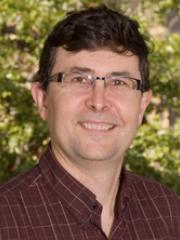Professor James De Voss

Primary research interest
Biological and synthetic chemistry
About me
After graduating from The University of Queensland with First Class Honours in Organic Chemistry I received a Royal Commission for the Exhibition of 1851 Overseas Scholarship to carry out my PhD on the biosynthesis of Vitamin B12 at the University of Cambridge. Upon completion of my studies, I moved to the Johns Hopkins University as a Royal Commission for the Exhibition of 1851 Postdoctoral Fellow and investigated the mechanism of action of the enediyne antitumour antibiotic calicheamicin. I then moved to the University of California San Francisco where I became interested in molecular biology and the enzmyes of the Cytochrome P450 family. I returned to The University of Queensland in 1995 as a Senior Lecturer and was appointed Professor in 2008.
Research focus and collaborations
My group is interested in problems at the interface of chemistry and biology. We apply chemical principles and techniques to understanding biologically important reactions. We are broadly interested in the way in which nature makes various compounds, the structure and bioactivity of these compounds and in the enzymes that are involved in these pathways. As the work carried out in my group is at the interface of chemistry and biology we use techniques that are drawn from both disciplines including recombinant DNA technology, protein purification and structure determination, organic synthesis, and small molecule structure determination by MS, NMR etc.
Cytochrome P450s
One group of enzymes that we work with are the cytochrome P450s. These are oxidative proteins that contain a prosthetic haem group and catalyse a fascinating array of transformations which range from simple epoxidations all the way through to oxygen insertion into unactivated C-H bonds and C-C bond cleavage. P450s are essentially ubiquitous in nature and we have projects involved with bacterial P450s, including ones from: Mycobacterium tuberculosis in collaboration with Prof Nick West and A/Prof Stephen Bell (University of Adelaide); thermophilic bacteria discovered via metagenomic sequencing of a Northern Queensland hot spring in collaboration with A/Prof Stephen Bell and Dr Paul Evans.
Natural products from herbal medicines
Herbal medicines have a long history of traditional use and are still widely used today with up to 70% of Australians in a recent survey reporting that they used Complementary and Alternative Medicines. The herbal medicine industry is a rapidly expanding and estimated to have annual revenues of up to $60 billion per annum world wide. Unfortunately, despite their widespread use, the chemical constituents of many of these herbal medicines are often poorly characterised. In collaboration with a local company we have embarked upon a program of phytochemical characterisation of a number of therapeutically prescribed herbs. The results have been surprising with a number of previously unknown compounds isolated from supposedly well-characterised species. We identify these compounds mainly via a range of 1D and 2D NMR techniques and in some cases we undertake the total synthesis of these new compounds.
Funded projects
- ARC Discovery Project (2024-2026): New biocatalysts for selective chemical oxidations under extreme conditions
Teaching interests
- Organic Chemistry in first, second, third and fourth year
- Organic Reactions and Mechanisms
- Introduction to Structure Elucidation
- Enantioselective Organic Synthesis
- Stereoelectronic Effects in Organic Chemistry
Featured publications
- Kirk, Alicia M., Stok, Jeanette E., Wong, Siew Hoon, Coleman, Tom, Challinor, Victoria L., Herring, Joel N., Bruning, John B., Bernhardt, Paul V., Bell, Stephen G., Krenske, Elizabeth H., and De Voss, James J. (2025). An Asynchronous, Concerted Mechanism for Cytochrome P450-Catalyzed Dehydrogenation: A Combined Deuterium Labeling and QM/MM Study. ACS Catalysis 15 (2) 1274-1286. https://doi.org/10.1021/acscatal.4c06278
- Giang, Peter D., Churchman, Luke R., Buczynski, Julia B., Bell, Stephen G., Stok, Jeanette E., and De Voss, James J. (2024). CYP108N14: a monoterpene monooxygenase from Rhodococcus globerulus. Archives of Biochemistry and Biophysics 752 109852 1-8. https://doi.org/10.1016/j.abb.2023.109852
- Coe, L. J., Zhao, Y., Padva, L., Keto, A., Schittenhelm, R., Tailhades, J., Pierens, G., Krenske, E. H., Crusemann, M., De Voss, J., and Cryle, M. J. (2024). Cytochrome P450Blt enables versatile peptide cyclisation to generate histidine and tyrosine containing crosslinked tripeptide building blocks (vol 61, e202204957, 2022). Angewandte Chemie-International Edition 63 (26) e202408719 . https://doi.org/10.1002/anie.202408719
- Churchman, Luke R., Giang, Peter D., Buczynski, Julia B., Stok, Jeanette E., Bell, Stephen G., and De Voss, James J. (2023). Synthesis of substituted norcaranes for use as probes of enzyme mechanisms. Organic and Biomolecular Chemistry 21 (48) 9647-9658. https://doi.org/10.1039/d3ob01571h
- Miller, Justin C., Lee, Joel H. Z., Mclean, Mark A., Chao, Rebecca R., Stone, Isobella S. J., Pukala, Tara L., Bruning, John B., De Voss, James J., Schuler, Mary A., Sligar, Stephen G., and Bell, Stephen G. (2023). Engineering C–C bond cleavage activity into a P450 monooxygenase enzyme. Journal of the American Chemical Society 145 (16) 9207-9222. https://doi.org/10.1021/jacs.3c01456
Researcher biography
James De Voss received a B. Sc (Hons) in Chemistry and a University Medal from the University of Queensland in 1984. He was a Royal Commission for the Exhibition of 1851 scholar at Cambridge University, where he worked on the biosynthesis of Vitamin B12 with Prof. Sir Alan Battersby. A postdoctoral fellowship, again from the Royal Commission for the Exhibition of 1851, allowed him to work with Prof. Craig Townsend at Johns Hopkins University on the mechanism of DNA cleavage caused by the enediyne antibiotic calicheamicin. He was then introduced to the cytochromes P450 by Prof. Paul Ortiz de Montellano with whom he worked while at the University of California, San Francisco. Since returning to the University of Queensland to take up an academic appointment, initially as a Senior lecturer and subsequently as a Reader and then a Professor, he has continued his interest in problems at the interface of chemistry and biology and currently works with a range of bacterial, insect and mammalian P450s, as well as on the biogenesis of insect pheromones and phytochemistry of herbal medicines.
